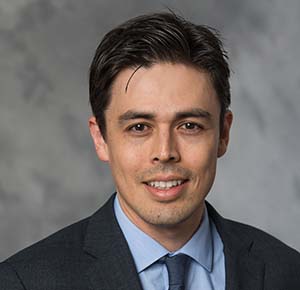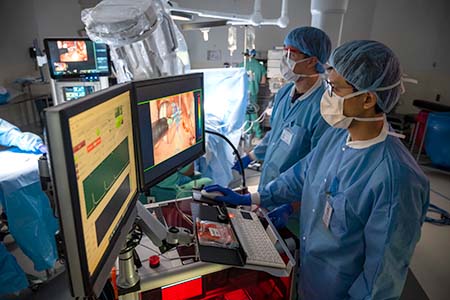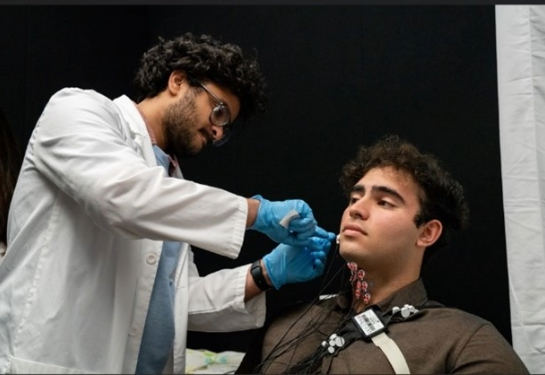Potential noninvasive low-cost test for head and neck cancer
Study finds promising saliva and urine-based biomarkers to help detect head and neck cancer
Can screening for head and neck cancer one day be as simple as a urine or saliva test?
A team of UC Davis Health researchers are hoping to develop a noninvasive, low-cost test to help screen for possible head and neck cancer (HNC). Their study, published in Diagnostics, found that the levels of three polyamine molecules in saliva and urine samples of head and neck cancer patients were significantly higher than those in healthy individuals.
Detecting head and neck cancer
Head and neck cancer forms in the oral cavity, throat, voice box, salivary glands, sinuses or nasal cavity. With over 800,000 new cases and 400,000 deaths annually, it is the seventh most common cause of cancer-related death.

Early detection is critical for effective treatment. In most cases, head and neck cancer is not clinically detected in its early stages.
“Around two-thirds of patients are with advanced stage III or IV tumors at the time of diagnosis,” said Andrew C Birkeland, assistant professor at the Department of Otolaryngology-Head and Neck Surgery and co-lead author of the study. “We are always looking for better ways to detect cancer early and catch signs of possible recurrence after treatment.”
Patients usually seek medical care after their cancer spreads to their lymphatic system, or they have symptoms linked to later-stage disease. These symptoms include pain, bleeding, ulcers, earache and difficulty swallowing.
Looking for signs of head and neck cancer in biofluids
Polyamines are metabolite components necessary for cellular growth and tumor progression. Higher polyamine levels have been found in breast, colon and prostate cancer patients and are linked to worse cancer results.

Using very sensitive techniques to study metabolites, the researchers analyzed 107 saliva and 124 urine samples from 39 HNC patients and 89 healthy participants. Nineteen of the patients had cancer in its early stage and 20 in its late stages. Most patients had cancer in their oral cavity or the back of their mouth.
The team measured the levels of three polyamines: N1-acetylspermine (ASP), N8-acetylspermidine (ASD), and N1,N12-diacetylspermine (DAS).
They found higher levels of ASD and DAS polyamines in the urine and ASP in the saliva of HNC patients compared to that of healthy individuals.
“Changes in metabolite levels in biofluids such as the saliva or urine can be important indicators of abnormal cell proliferation,” said Johnathon Anderson, assistant professor at the Department of Otolaryngology and co-lead author of the study.
Saliva and urine samples can be obtained in an easy, noninvasive and inexpensive manner. Saliva testing allows patients to gather their samples at home, saving health care costs and enabling a convenient way to collect multiple samples.

“Given the noninvasive nature of saliva and urine collection and the potential cost-effective metabolite analysis options, there are opportunities for developing screening tools for at-risk patients,” Anderson said.
This is a proof-of-concept study. Large scale studies are needed to provide more support for the preclinical and clinical development of these biomarkers for screening of head and neck cancer.
“To our knowledge, this is the first study to identify elevated levels of ASP, ASD and DAS polyamines in saliva and urine samples of HNC patients,” Birkeland said. “We hope science will advance to make testing for head and neck cancer as simple and accessible as an at-home pregnancy test.”
The project is a collaboration among UC Davis researchers at the West Coast Metabolomics Center and the Departments of Otolaryngology-Head and Neck Surgery, Radiation Oncology, and Neurology. It was funded by multiple National Institutes of Health (NIH) grants (K12CA138464, ES030158, T32-HL086350, T32-GM008799, U2C ES030158, R01GM099688, UL1 TR001860, KL2 TR001859). It was supported by California Institute for Regenerative Medicine (EDUC2-08390), the UC Office of the President’s Multi-campus Research Program Grant (MRP-17-454909), STAIR and STAIR-Plus grants, and Denny & Jeanene Dickenson Fellowship.
UC Davis Comprehensive Cancer Center
UC Davis Comprehensive Cancer Center is the only National Cancer Institute-designated center serving the Central Valley and inland Northern California, a region of more than 6 million people. Its specialists provide compassionate, comprehensive care for more than 100,000 adults and children every year and access to more than 200 active clinical trials at any given time. Its innovative research program engages more than 240 scientists at UC Davis who work collaboratively to advance discovery of new tools to diagnose and treat cancer. Patients have access to leading-edge care, including immunotherapy and other targeted treatments. Its Office of Community Outreach and Engagement addresses disparities in cancer outcomes across diverse populations, and the cancer center provides comprehensive education and workforce development programs for the next generation of clinicians and scientists. For more information, visit cancer.ucdavis.edu.




